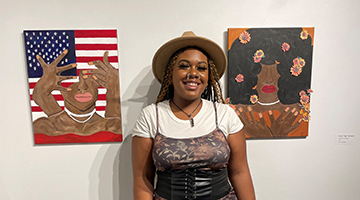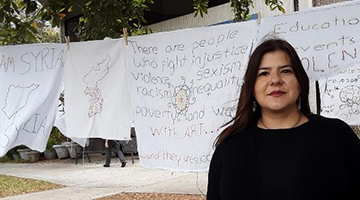Voces y Caras: Preserving History
 People have been telling stories long before the written word. These stories — often called active learning projects — bring depth to understanding the past and are meant to invoke feelings and emotions to heal, help, encourage and to learn about real-life tangible experiences.
People have been telling stories long before the written word. These stories — often called active learning projects — bring depth to understanding the past and are meant to invoke feelings and emotions to heal, help, encourage and to learn about real-life tangible experiences.That is the premise behind the Voces y Caras: Hispanic Communities of North Florida exhibit on display now through Oct. 14 — during Hispanic Heritage Month — at Founders Hall at the University of North Florida Gallery of Art.
Featuring more than 200 oral histories collected over a decade, the personal stories of members of the North Florida Hispanic community, document lives once lived, dreams, hopes and experiences immigrating to the U.S.
The project celebrates the Hispanic community’s heritage and language — the first European language spoken in the state of Florida, said Dr. Constanza López, associate professor in the Department of Languages, Literatures and Culture. Students interview family members and friends to document their experiences as immigrants. Students who engage in this rich experience, learn first-hand about the historical events that led their family and friends to travel to a new land.
Natalie Echevarria-Pedrianes is a former student who interviewed her cousin, Alain — a recent immigrant from Cuba. She said the project was especially important to her and her family because it gave them a chance to tell their side of the story.
“Oftentimes, history — even with today’s news — is written and told by people who were not there and did not experience the events,” said Echevarria-Pedrianes. “I think the oral histories are important because they give back power to the people to tell their own story.”
“What started out as a spring semester project in 2012 with 23 students representing different countries throughout Latin America and Spain, has grown into an annual event with more than 200 students thus far, and with 19 students participating this year,” López said.
“It’s a way for us to remember and celebrate our histories, our culture and contributions as immigrants who add to our society as hard-working people,” López said. “The interviewees have responded with enormous gratitude for being listened to and valued as people.”
Since its inception, the oral history project has grown into an interdisciplinary, multimedia exhibit that includes artwork and other historical items that tell the stories of change, value and traditions.
López said many of her students in her Communications and Communities for Heritage Speakers class come back each year to help with the project.
“Voces y Caras is a project very dear to my heart since I interviewed my own father,” said Jessika Cardozo, a former student of López, now working as her intern. “My father told me his story about his childhood and his views looking back on his own life. At the end, I felt closer to my him and he made me proud. I hoped his words would inspire others.”
Alondra Solares, who took López’s class this past spring, is one of a few students accompanying her to Mexico in November, for the 6th Annual Conference of Digital Humanities. Solares said the goal of the trip is to help others relate to the importance of documenting their stories.
“I want to share how invaluable this project has been to the Hispanic community in North Florida,” said Solares. “We’re going to Mexico to help others to visualize the importance, too.”
“I am grateful to so many people for their contributions and assistance with this project over the years,” said López. “Because of the dedication of so many from various departments throughout the University, this project is a success. It wouldn’t have come together so well without their efforts.”
 In addition to the Voces y Caras exhibit, López also initiated an embroidery art project, Embroidery for Peace and Memory. In a 2019 interview with The Spinnaker, López said she was inspired to create the embroidering project after learning about a group of South American women who were creating artistic testimonials of their past as remembrances of their loved ones who disappeared.
In addition to the Voces y Caras exhibit, López also initiated an embroidery art project, Embroidery for Peace and Memory. In a 2019 interview with The Spinnaker, López said she was inspired to create the embroidering project after learning about a group of South American women who were creating artistic testimonials of their past as remembrances of their loved ones who disappeared.The collection grew over time and other topics were added, including the anti-war movement, the environment and human rights.
“It doesn’t matter whether these messages are expertly sewn or not, they are messages of hope, longing and peace to inspire people to reflect on the state of the world and its people. The power of these bits of cloth and thread is undeniable,” López said.
Since 2012, approximately 600 pieces of embroidery have been produced in more than 13 languages, highlighting the culture and diversity of UNF and the North Florida community.
The Embroidery for Peace project will take place Oct. 16 –19 at the Language Lab. This annual project is open to all and brings together faculty, staff and students to embroider messages of peace and stories that highlight culture and diversity on pieces of white cloth.
Also, plan to check out the screening of “Noise/Ruido,” part of the Movies on the House (MOTH) series on Wednesday, Oct. 18. This film depicts how families are shattered by violence and prevailing corruption when their loved ones disappear. The third film by Nataliz Beristáin that allows us to recognize through the eyes of a mother, the pain of loss. This year, Dr. Andrea Gaytán Cuesta, associate professor in the Department of Language, Literature and Cultures is heading up the lineup of MOTH movies. Wednesday, Oct. 18 at 7:30 p.m., UNF Gallery of Art, Building 2, Room 1101.
Learn more about Voces y Caras: Hispanic Communities of North Florida.
